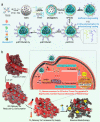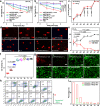A hybrid semiconducting organosilica-based O2 nanoeconomizer for on-demand synergistic photothermally boosted radiotherapy
- PMID: 33483518
- PMCID: PMC7822893
- DOI: 10.1038/s41467-020-20860-3
A hybrid semiconducting organosilica-based O2 nanoeconomizer for on-demand synergistic photothermally boosted radiotherapy
Abstract
The outcome of radiotherapy is significantly restricted by tumor hypoxia. To overcome this obstacle, one prevalent solution is to increase intratumoral oxygen supply. However, its effectiveness is often limited by the high metabolic demand for O2 by cancer cells. Herein, we develop a hybrid semiconducting organosilica-based O2 nanoeconomizer pHPFON-NO/O2 to combat tumor hypoxia. Our solution is twofold: first, the pHPFON-NO/O2 interacts with the acidic tumor microenvironment to release NO for endogenous O2 conservation; second, it releases O2 in response to mild photothermal effect to enable exogenous O2 infusion. Additionally, the photothermal effect can be increased to eradicate tumor residues with radioresistant properties due to other factors. This "reducing expenditure of O2 and broadening sources" strategy significantly alleviates tumor hypoxia in multiple ways, greatly enhances the efficacy of radiotherapy both in vitro and in vivo, and demonstrates the synergy between on-demand temperature-controlled photothermal and oxygen-elevated radiotherapy for complete tumor response.
Conflict of interest statement
The authors declare no competing interests.
Figures







References
Publication types
MeSH terms
Substances
Grants and funding
LinkOut - more resources
Full Text Sources
Other Literature Sources

